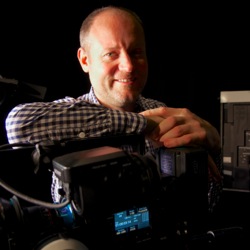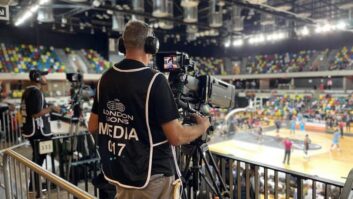
Although it is possible to do a live production in 4K — as Sony, Telegenic, HBS and FIFA TV demonstrated during the recent Confederations Cup in Brazil, when they covered three live matches in quick succession — it is not simple. There are elements we take for granted in HD, such as wireless links, that don’t yet exist for Ultra HD, while none of the large-sensor cameras are ideally suited to broadcast shooting requirements.
However, the combination of a clever feature in Ross Video’s vision mixers, a ‘zero delay’ HD wireless system and an easy post production workflow could provide a relatively low-cost method of producing fast turnaround productions in 4K that would be particularly suitable for live events, such as concerts, or for studio drama.
With so few UHD services in place there is currently little need to transmit 4K live, but live workflows are often the best way to cover an event. So, with no immediate prospect of being able to provide a suitable 4K wireless link, Scott Walker (pictured), co- founder of wireless specialists Boxx TV, has come up with a neat solution for enabling cable-free shooting in UHD.
“The easiest method is to have a live-to-media production, where you record native 4K in the camera. You then transport an HD signal, via cable or wireless, and with a Boxx zero delay system there is no difference in timing to the gallery or OB van. The director would use a mixer made by Ross Video that has an ingenious capability that allows you to put timecode into the vision desk that then creates an EDL based on the camera selection. It can then output the EDL on a USB stick.”
The LiveEDL edit decision list feature is available on Ross’s compact CrossOver range as an option, and comes standard on the more extensive Carbonite series “so you can use it with lots of different types of production or budget,” he says.
“We sync the cameras to a master clock that is also feeding the vision desk, and we can then walk into an edit suite and quickly create a 4K master of the event. On the day, you’re not recording the 4K out, but the EDL, so every single camera is also ISO recording, which gives you infinite opportunities to make changes in the edit.
“It means you can have a completely wireless studio or shoot a concert, say, in a listed building where it is difficult to go cabled. You can use wireless to get you to a level of production that is very flexible, yet still deliver in 4K.”
“The desire is out there” for 4K live production, but “it is not yet being met by the manufacturers,” adds Nick Badham, head of project management, Procam TV, a UK-based hire company that has several 4K-capable cameras on its books: the Sony F65, the PMW-F55, PMW-F5 and NEX-FS700, and the Red One MX. All of Procam’s 12 F55s are regularly out, and it is buying more.
Badham believes that Walker’s idea would be suitable for multi-camera shoots with the Sony F55, where the 4K would be recorded in the camera, while an HD signal could be sent wirelessly to the OB truck. Many of Procam’s customers want to do this style of shooting “and to go cable free is a great advantage.” Procam typically uses fibre, via Telecast Fiber’s Copperhead or wireless via a Boxx TV system with the F55, which can have tally, comms, timecode, reference and sync lock and send an HD feed out for the vision mixer via either system.
“The Ross LiveEDL capability is very exciting, specifically for this type of shooting,” he says. “It will help keep the costs down. If you can record ISO in the camera (on any camera) you only need a main and backup vision mix VT instead of a truck full of them.”
Using the F55 with a vision mixer like this can make it a lot simpler, and cheaper, in post to auto-conform a 4K edit or to stay in the native production format the whole-way through post.
Although Badham has worked on shoots with Ross vision mixers, Procam doesn’t have any in its range. However it is considering buying some as part of a new investment in mixers for a wide range of programme production (from robotic cameras on reality shows to multi-camera corporate shoots and big studio productions), all of which have different requirements “so the final choices have to be carefully made to accommodate all considerations,” he says.
Long and expensive development process
Ideally, UHD productions would be able to use 4K wireless links. “However, getting a practical 4K wireless system isn’t so simple, as it’s eight times the bandwidth of current products,” says Walker. Boxx has done some experiments, but these just show that it will take a long and expensive development process to deliver full UHD mobile links.
“One prospect could be to go to a very high frequency, such as 60GHz, which offers a lot more bandwidth, but the range [carrying distance] is significantly reduced. The other is to multiplex four HD signals together, but the timings required have nanosecond limitations. When transporting 4K, even over four separate BNC cables, it’s important to have those four cables exactly the same length,” he explains.
“This is because the timing differentials between the four signals are extremely small, so when trying to work with these parameters over wireless it adds a whole new level of timing issues that have to be resolved. It would probably require some sort of buffering, which would add at least another frame delay — but it would also require very accurate and fast processing.”
60GHz has about 6GHz of bandwidth, which is mostly licence exempt (depending on the country). “At the moment, these frequencies are being used for short-haul Ethernet connections. In a line of sight, when you have extremely narrow beam connections, it goes about 4-5km. But, you can’t use a directional antenna off the back of a camera because it’s moving, so it would be sub 50m, which might work in a studio or where you have a tracker running next to a Steadicam operator, but you are certainly not going to see technology at 60GHz to cover a golf course, unless it is used simply for point-to-point links,” adds Walker.
“When you are at 60GHz, there is no loss whatsoever, so the quality is exactly the same as if using a cable.” There is also hardly any delay. Boxx’s current, ‘zero delay’ HD wireless link, Meridian, has a delay of less than one millisecond (less than 1/30th of a frame), but 60GHz is less than 0.000002 milliseconds.
Broadcast facilities
Of course, while there is a considerable desire to shoot 4K like this, it will take a while for the talk to translate into productions — but Badham is confident it will. Many directors, typically of music videos or light entertainment, like to shoot on F55s for high-end broadcast work or commercial projects, primarily to get the shallow depth of field and filmic look, although many are currently happy with HD, he says.
Before the arrival of the F55, some multicam productions were shot using Canon’s C300 (HD) camera, such as an eight-camera Alicia Keys video Procam was involved with late last year, but most such productions now prefer the Sony 4K camera, partly because most C300 models have been sold with EF lens mounts, which restricts the choice of lenses to mainly those designed for stills use. Although there are some PL-mount C300s in use, they are a minority. The F55s can all be fitted with PL-mount lenses, which are much more suitable for video use, (although they do cost a lot more).
However, “the issue with these cameras and lenses is that they are still film style. You can’t control the camera in the same way you would a broadcast system camera.”
Even Fujinon’s new Cabrio PL-mount lenses (the ZK3.5×85 85-300mm and ZK4.7×19 19-90mm), which have a detachable servo drive unit so that they can be remotely controlled for zoom and focus, can’t have remote iris control via OB/Studio system type OCPS. Similarly, the F55 can’t be used with a remote operational control panel.
“It would be a lot more usable if you could rack all the cameras with a vision engineer and have a TV cameraman doing zoom and focus with controls he is familiar with, and do away with the camera assistant,” says Badham. “But, the manufacturers aren’t offering this. You have to have a camera assistant to do iris and focus, which doubles the labour bill, puts equipment costs up (focus pullers need monitors and sometimes wireless links), and makes it harder to position the cameras because of extra space demands.”
He comes across numerous directors who’d like to do multi-camera shoots with these large sensor cameras, but producers don’t want to pay for camera assistants and film style zoom, focus and iris controls. “But when they can afford it, it looks very sexy.”
Live productions make the producers even more nervous, because they want one person to control the iris on all the cameras, so that everything matches. The lack of standard broadcast remote controls on the cameras and lenses makes it a lot more difficult to justify using large sensor cameras (or 4K, as there are no 2/3-inch UHD cameras) for live or as-live productions. “The differences between film-style and television-style shooting have been massive for a long time. But now that the two disciplines are converging, it’s a pity the manufacturers haven’t realised that,” says Badham.
“How come lens and camera manufacturers didn’t think TV OB people would want to use this kit in television set ups? We have many clients who’ve said ‘What a shame they haven’t gone that one step further to allow us to work with these cameras this way’. It is frustrating, but I am sure it will happen eventually.”
He recently got a three-page email from an exasperated director wanting to shoot like this “if only you could remote iris the lenses…” He’s hoping Sony and the lens manufacturers will work together on addressing this.
By David Fox







